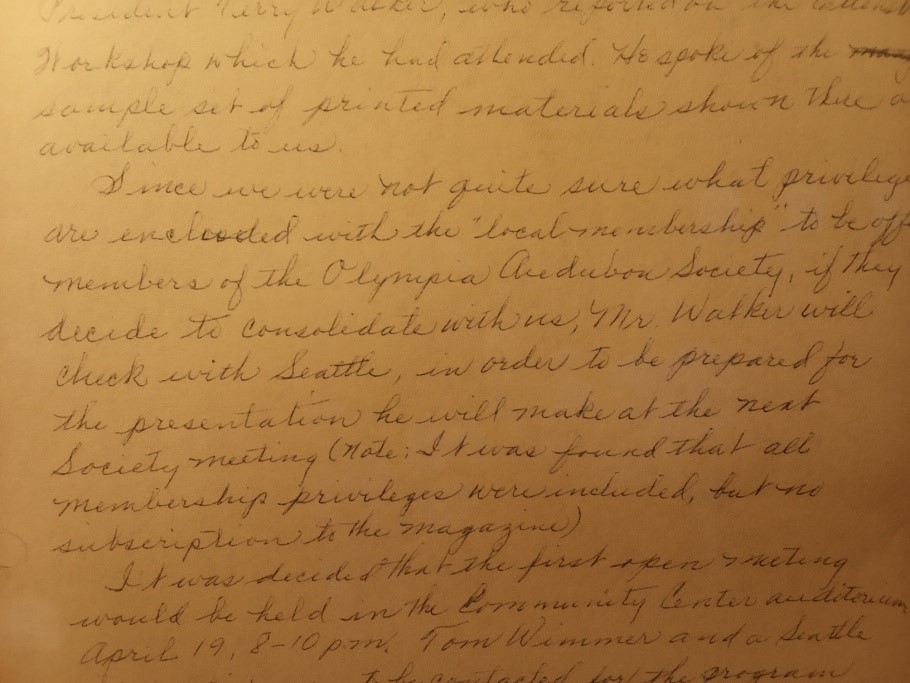FIFTY YEARS AND COUNTING!
Kathleen Snyder
In one of my more generous moods, I offered to organize all the old BHAS Board minutes that were being held in our storage unit. I waited for a rainy day and a big one arrived on December 5th so I started.
It turned out this project was a revelation. The first minutes I found were from February 1973, hand-written and were clearly not from the first time the group had met. They had officers; Terry Walker was President. Do the math and it becomes clear that our chapter has been active for over 50 years. Isn’t that something?
In celebration of our 50th anniversary, I am reading the minutes and will summarize them for you by decade. This first article will have highlights of the 1970s. It was a different world back then, especially concerning communication with members and the general public. I need to point out that the minutes contain mistakes and gaps and many times lacked background information that would make the subject being discussed understandable by someone 50 years later. As the current BHAS Secretary, I have taken this to heart and will be careful in my own recording efforts.
In 1973, there was another local Audubon chapter – the Olympia Audubon Society which had been organized by Margaret McKinney. By May, the two chapters had amicably merged. The first BHAS field trip was held at Scatter Creek Game Reserve (I guess that was its original name). The first speaker program featured Dr. Fred Tobiason on “Man in an Urban Environment”. Meetings were held at the Olympia Community Center. The minutes speak to choosing “Black Hills” for our name but not why it was chosen.
The biggest BHAS event that I found so far was held in October of 1973; about 900 people attended our Mushroom Show with Dr. Benedict as the keynote speaker. It was a great success but, unfortunately, no one would volunteer to organize another one, at least through 1979.
The conservation campaigns during this time included stopping Protection Island development, fighting the use of DDT against the Tussock moth, dealing with the Port of Olympia’s lack of sewage treatment, fighting against a deep water port at Nisqually by Weyerhauser, and preserving Juniper Forest. Some of these efforts were successful, some not. Black Hills was active and committed and you can be proud of this heritage.
It is also fun to mention the less important issues that the board dealt with: when to make long distance calls for the cheapest rate, typing stencils for the newsletter, burned-out projector bulbs, and mimeograph machine repairs. The funniest sentence I came across was this, “XXXXX also brought us up-to-date on work of Olympia Park Associates (1/2 hour, most of which was not news)”.
In 1977, we collaborated with the new Washington Environmental Council to set up shared office space in downtown Olympia for $65 per month. Eventually we moved into our own space at the Margaret McKinney House. We hired a college intern in 1978 for a total of $245 for 6 months. She led the Conservation Committee and was a real go-getter. There was an overnight camping trip in Capital Forest, the publication of a three county bird checklist and a constant struggle to find volunteer leaders to steer the organization. A real surprise was to find out that Bill Tweit was our president starting in 1979. He was the compiler for the first Olympia circle Christmas Bird Count, also in 1979.
Speaking of birds, there are two references in the minutes that are worthy of sharing. One was that in 1977, Lake Lawrence was considered one of the last areas in Thurston County were eagles would come to eat. The other was that in 1978, Ada and Jack Davis (Board members) reported the first Barred Owl sighting in Thurston County.
If anyone is interested in viewing these minutes, please contact me at ksnyder75@nullgmail.com. I’ll be back next month with a summary of the 1980s.
Photo by Kathleen Snyder








